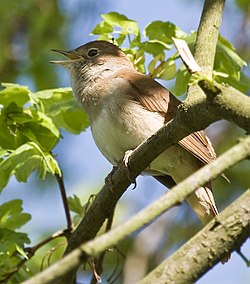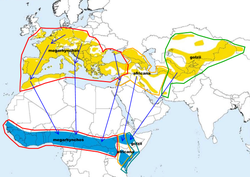Nightingale
The nightingale (Luscinia megarhynchos) is a small bird. It used to be put in the thrush family Turdidae. Now it is put on the Old World flycatchers, a group often called the chats or chat-thrushes. Its resemblance to thrushes is an example of convergent evolution.
| Nightingale | |
|---|---|

| |
| Conservation status | |
| Scientific classification | |
| Kingdom: | |
| Phylum: | |
| Class: | |
| Order: | |
| Family: | |
| Subfamily: | Saxicolinae
|
| Genus: | |
| Binomial name | |
| Luscinia megarhynchos | |
It is a migratory insectivorous species. It breeds in forests and scrubs in Europe and south-west Asia. The distribution is more southerly than the very closely related thrush nightingale Luscinia luscinia. It nests on the ground in or next to dense bushes. It passes the winter southern Africa. Studies have shown that nightingales seem to choose places to breed that meet certain criteria (Wink 1973):
- less than 200 meters above mean sea level
- mean air temperature during the growing season above 14 °C
- more than 20 days/year on which temperatures are above 25 °C
- less than 750mm of rain per year.
- no closed canopy.
The Nightingale is slightly larger than the robin, at around 15-16.5 cm length. It is plain brown above except for the reddish tail. It is buff to white below. Sexes are similar.
Nightingales are named so because they frequently sing at night as well as during the day. The name has been used for well over 1,000 years, being highly recognizable even in its Anglo-Saxon form - 'nihtingale'. It means 'night songstress'. Early writers assumed the female sang; in fact, it is the male.
The song is loud, with an impressive range of whistles, trills and gurgles. Its song is particularly noticeable at night because few other birds are singing. This is why its name (in several languages) includes "night". Only unpaired males sing regularly at night, and nocturnal song is likely to serve attracting a mate. Singing at dawn, during the hour before sunrise, is assumed to be important in defending the bird's territory. Nightingales sing even more loudly in urban or near-urban environments, in order to overcome the background noise. The most characteristic feature of the song is a loud whistling crescendo, absent from the song of thrush nightingale. It has a frog-like alarm call.
Culture
- A Provençal folk song, The Nightingale Which Flies, inspired Tchaikovsky when composing his Humoresque opus 10-2.
Nightingale Media
Song recorded in Devon, England
References
- BirdLife International (2004). Luscinia megarhynchos. 2006 IUCN Red List of Threatened Species. IUCN 2006. Retrieved on 12 May 2006. Database entry includes justification for why this species is of least concern
- Wink, Michael (1973): Die Verbreitung der Nachtigall (Luscinia megarhynchos) im Rheinland. Charadrius 9(2/3): 65-80. [Article in German] PDF fulltext
Other websites
| Wikimedia Commons has media related to Lua error in Module:Commons_link at line 62: attempt to index field 'wikibase' (a nil value).. |
| Wikispecies has information on: Luscinia megarhynchos. |
- Internet Bird Collection: Nightingale videos. Retrieved 2006-DEC-09.
- The Freesound Project: High-quality Nightingale sound file Archived 2007-10-12 at the Wayback Machine (requires free account to download). Retrieved 2006-DEC-09.
- Royal Society for the Protection of Birds (British)- Nightingale [1]. Retrieved 2007-JUN-11.
- Rose and nightingale in Persian art [2] Archived 2008-12-07 at the Wayback Machine and in Persian literature [3] Archived 2008-01-22 at the Wayback Machine
- Nightingale song and behavioural ecology [4] Archived 2008-06-18 at the Wayback Machine
- Ageing and sexing (PDF) by Javier Blasco-Zumeta Archived 2012-03-17 at the Wayback Machine



